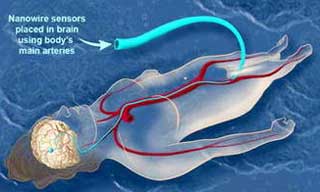Researchers from NYU medical school, the University of Tokyo and the MIT have demonstrated a technique that may one day allow doctors to monitor individual brain cells and perhaps provide new treatments for neurological diseases such as Parkinson’s.
In an experiment, the team guided platinum nanowires into the vascular system of tissue samples, and then used the wires to detect the activity of individual neurons lying adjacent to the blood vessels.

They envision connecting an entire array of nanowires to a catheter tube that could then be guided through the circulatory system to the brain. Once there, the wires would spread and branch out into tinier and tinier blood vessels until they reached specific locations. Each nanowire would then be used to record the electrical activity of a single nerve cell or small groups of them.
If the technique works it would be a boon to scientists who study brain function.
The technique could also help pinpoint damage from injury and stroke, localize the cause of seizures, and detect brain abnormalities. Better still, the nanowires could deliver electrical impulses as well as receive them.
One challenge is to precisely guide the nanowire probes to a predetermined spot. One promising solution is to use new conducting polymer nanowires. The polymers conduct electrical impulses, change shape in response to electric fields, are 20 to 30 times smaller than the platinum ones and will also be biodegradable, and therefore suitable for short-term brain implants.
Via PhysOrg.
